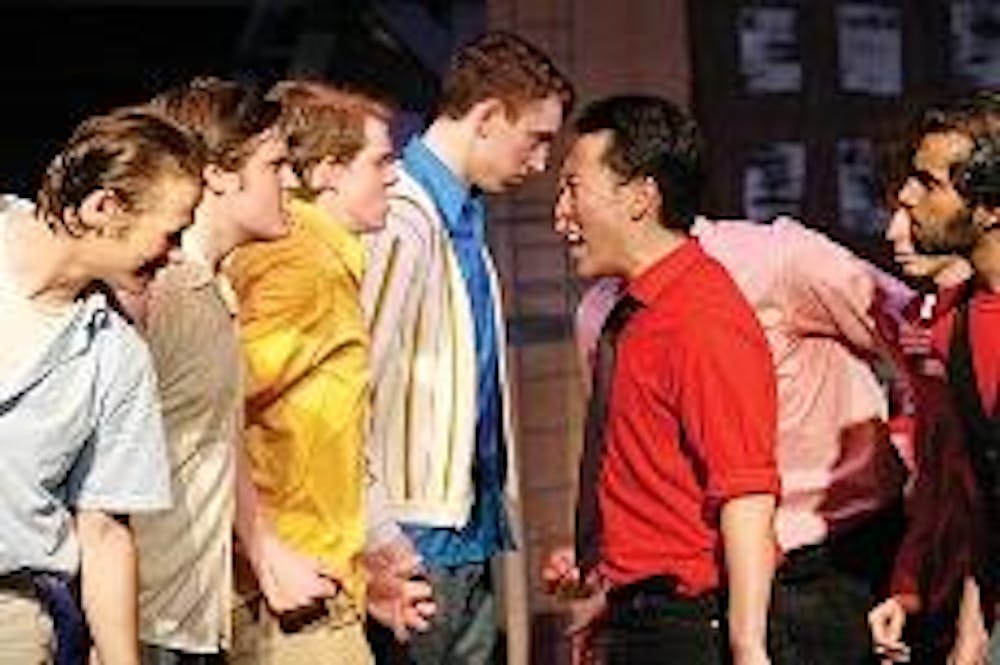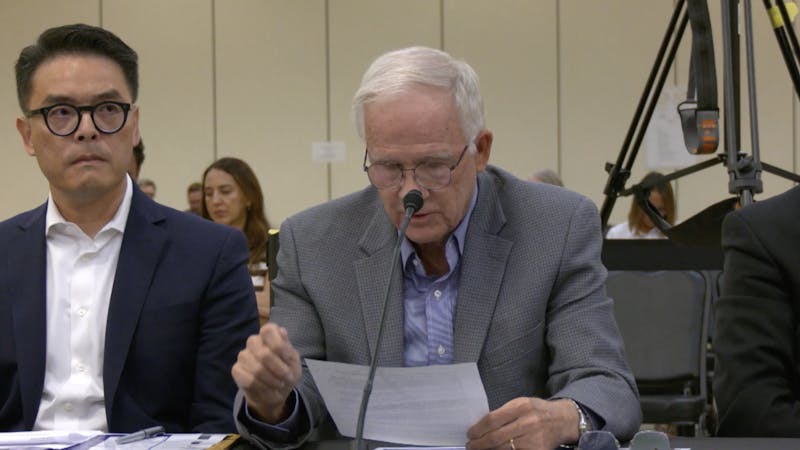Taking a ride on the West Side ... Story

Jets' leader Riff (Lovett senior Paul Early) and Sharks' leader Bernardo (Brown senior Matt Youn) face off during a neighborhood dance in the first act of Wiess Tabletop's West Side Story, playing this weekend and next weekend at Wiess College.
With tremendous productions like Urinetown (2007) and Hello, Hamlet! (2008), in recent years Wiess Tabletop Theater has established itself as the annual college musical theater powerhouse. But the reputation is double-edged: this year's production, West Side Story, carried with it fantastic potential and extraordinary expectations. When the stars align and all the gears within the production synchronize, the product is riveting. Unfortunately, these moments are spread too thin across the production's two-hour runtime. Wiess may have bitten off more than it can chew.West Side Story, written by Leonard Bernstein and Stephen Sondheim, is a 1957 adaptation of Romeo and Juliet that replaces the feuding Montague and Capulet families with two Hell's Kitchen street gangs: the all-Anglo Jets and the Puerto Rican Sharks. The show has become one of the more influential works in the history of American musical theater, largely because of the unprecedented complexity of its choreography and innovative music. Producing the show necessitates a fastidious attention to the details of its dancing and its music, and for the most part Wiess's production succeeds with only a few lapses.
Lovett junior and head choreographer Natalia Salies's work is exhilarating and is by itself worth the cost of admission. Assisted by Hanszen sophomore Delphine Zimmern and Hanszen junior Teresa Ann Virginia Bayer, Salies brings unyielding energy to the production as swarms of Jets and Sharks throw themselves across the stage in intricate, expressive dance numbers.
The cast of West Side Story features a handful of markedly talented dancers among a group of more amateur performers, although some rough patches of loose timing bog down less energetic numbers. What the show might lack in precision, however, it reclaims with spectacle. If a world existed in which street gangs broke into spontaneous dance, these Jets and Sharks would call it home.
The tremendous 28-member orchestra has undeniably been expertly coached by music director and Wiess senior Daniel Young. They are talented, and as an ensemble they function admirably. Among their best performances is second-act standout "Gee, Officer Krupke," a delightful ride through the chronically-underappreciated low brass section punctuated by tight, chirpy exclamations from the woodwinds and violins. The orchestra is large and powerful, but because its members face the audience they flirt with drowning out the performers' words in the show's bigger, louder numbers.
With 36 members, West Side Story boasts one of the largest college theater casts in recent memory. As an ensemble their choreography is captivating but their voices are frequently muffled, both by the orchestra and unclear articulation.
As individuals the cast displays a wide range of talent and experience. With radiant voice and precise poise, Baker freshman Erin Dahlstrom delivers one of the year's best leading performances as Puerto Rican belle Maria. Rice theater can only hope she remains a mainstay for the rest of her time here.
Her counterpart, Jet heartthrob Tony, is played by Martel junior Charlie McKean. McKean has repeatedly demonstrated that he has a superb voice, often unparalleled in college theater, and while it is on full display in first-act highlight "Tonight," McKean struggles to fill his spoken performance with the same level of emotional depth. The two excel in duets, but not as a couple - we can believe they're in love, just perhaps not with each other.
Two supporting actors command their time on the stage masterfully. Baker sophomore Meena Awasthi, as Maria's confidante Anita, fills every second of stage time with rejuvenating enthusiasm, a stunning red dress and some of the production's best dancing. Action, a Jet played by Wiess senior Jason Hawley, offers only a passable voice but an intensely resplendent physicality which he sustains throughout the entire performance. Hawley has a face that expresses with great dynamism the fullest range of emotion afforded to his character. Wiess master Mike Gustin, in a move that demonstrates adorable and hilarious dedication to his college, adopts a flattop and a bow tie as show-stealing emcee Glad Hand.
Set design by Wiess junior Charles Lena is functional, if not flashy. A backdrop of tenement buildings is eye-pleasing but perhaps not neutral enough to differentiate between different locations across the scenes. Wiess junior Dhruv Venkatraman's technical direction is skillfully unobtrusive, and Wiess sophomore Nick Hoeft commands the sound board with noticeable precision. He mixes the five-layered "Tonight" in such a fashion that we can hear all the performers at once, and as a result the song is one of the show's strongest.
Even with so many strong performances, West Side Story is not free from its share of problems. The production is plagued with disconnect: Disconnect between scenes, disconnect between performers and the orchestra, disconnect between the production and the audience and disconnect between the limitations of the venue and the needs of a performance space. Too often the performers give the impression that they're presenting a slideshow of West Side Story: The Revue. They drift from scene to scene not because of any internal characterization but because, quite simply, it's what they've rehearsed.
All of these shortcomings stem from a common source: Wiess itself. Wiess Tabletop Theatre has come a long way since its literal tabletop origins in 1966, but the current Wiess commons is a space lamentably inadequate for the scale of the production that directors Caitlin Miller and William Figueroa, both Wiess juniors, wish to present. Its glass-gridded window is meant for mealtime socialization in the sunshine, and lights from the Acabowl peek into the commons and distract from the onstage action.
Complicating things further, the orchestra and technical board have set up camp between the stage and the audience. For want of a better location, they have built a buffer zone of wide space and loud sound and it is here that the production hamstrings itself. There is no good place for the orchestra to relocate, but the show will never reach its full potential while the musicians interfere with the audience experience.
This flawed environment demands that the actors tap into a deeper source of energy and project themselves beyond those things which would otherwise impede them. In West Side Story, those parts of the performance which cannot hurl themselves across the gap are muffled and weak. Those which can are sublime.
More from The Rice Thresher

Rice announces Chao College as 12th residential college
Rice announced that the 12th residential college will be named Ting Tsung and Wei Fong Chao College Aug. 19. The college, set to open in fall 2026, will contain nearly 300 on-campus beds.
Dining access fund announced following on-campus unlimited meal swipes
Rice announced new food assistance programs on Tuesday to account for the controversial change in the on-campus meal swipe plan.

Rice disaster prediction model discussed at hearing on deadly Central Texas floods
The House and Senate Select Committees on Disaster Preparedness and Flooding held a hearing on July 31 in Kerrville to address the deadly July 4 flooding in Central Texas. The flooding along the banks of the Guadalupe River killed 108 people, including 37 children. In the charged hearing, Texas lawmakers and flood survivors criticized the local response to the disaster.


Please note All comments are eligible for publication by The Rice Thresher.